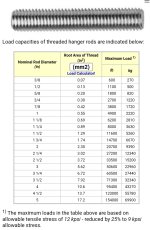mwayne
Gold Member
Maybe someone knowledgeable in mechanical engineering can explain a situation to me. I used some 1/2" all thread on a project and was told that the maximum tensile load I could allow for is 550 poundsper all thread. This was based on the information in a chart that I later found on engineering toolbox.com

 www.engineeringtoolbox.com
www.engineeringtoolbox.com
As it was explained to me, since the allowable load on a 1/2" threaded rod is 1100 pounds per inch (according to the chart) and I was using a nut that was about 1/2" thick then I was only able to put a 550 pound load on that all thread.
When the chart was presented to me the note at the bottom was cropped out, that note states "The maximum loads in the table above are based on allowable tensile stress of 12 kpsi - reduced by 25% to 9 kpsi allowable stress." My understanding is that all thread is based on 60kpsi material. For background what I did with the all thread and nuts is this: I rolled a 1200 pound transformer into extremely tight quarters on a dolly then used the all threads (2) that were attached to an overhead beam as a screw jack to lift the transformer off the dolly and then lower it down in place. The task was performed successfully and no strain or imminent failure was noted.
Can someone please explain why this chart is different from my expectation? Is hanger rod different from all thread? Did I come as close to fouling up as the ME said? Thanks in advance for your replies.

Threaded Rods - Loads in Imperial Units
Weight rating of threaded hanger rods.
As it was explained to me, since the allowable load on a 1/2" threaded rod is 1100 pounds per inch (according to the chart) and I was using a nut that was about 1/2" thick then I was only able to put a 550 pound load on that all thread.
When the chart was presented to me the note at the bottom was cropped out, that note states "The maximum loads in the table above are based on allowable tensile stress of 12 kpsi - reduced by 25% to 9 kpsi allowable stress." My understanding is that all thread is based on 60kpsi material. For background what I did with the all thread and nuts is this: I rolled a 1200 pound transformer into extremely tight quarters on a dolly then used the all threads (2) that were attached to an overhead beam as a screw jack to lift the transformer off the dolly and then lower it down in place. The task was performed successfully and no strain or imminent failure was noted.
Can someone please explain why this chart is different from my expectation? Is hanger rod different from all thread? Did I come as close to fouling up as the ME said? Thanks in advance for your replies.

